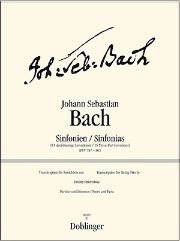Bach's symphonies for string trio
In Dmitry Sitkovetsky's transcription, Bach's "auffrichtige Anleitung" for dealing with three obbligato parts becomes usable and enjoyable for a string trio.

Bach had a pedagogical intention with his two-part inventions and three-part symphonies for piano. He wrote in the title of the 1723 manuscript: "Sincere instructions to show lovers of the piano, but especially those who are eager to learn, a useful way not only (1) to learn to play purely with two parts, but also (2) to proceed correctly and well with three obbligato parts during further progress, at the same time not only to get good inventiones, but also to perform them well, but above all to acquire a cantabile way of playing, and in addition to get a strong taste of composition."
Because these two- and three-part movements are consistently worked contrapuntally, they are very suitable for playing as a duo or trio. The string trio instrumentation (violin, viola and violoncello) also means that no octaves need to be added in any part that lies outside the range of the three instruments. This preserves the original voice leading. In this way, even string players who are unfamiliar with the keyboard can enjoy Bach's "sincere instructions" on how to play three obbligato parts and the "cantabile way of playing"!
The violinist Dmitry Sitkovetsky has given his transcription of the symphonies a meticulous technical bowing arrangement plus some phrasing indications. Occasionally, he has passages played in pizzicato, such as the theme of Sinfonia 9, which is in a chromatic lamento, where he occasionally uses octave doublings in the violin's pizzicati, probably to make them equal in sound to those of the viola and cello. In the other pieces, the pizzicato is mostly reserved for the violoncello. Sitkovetsky dispenses with indications of dynamics, tempo and fingerings. He therefore remains very close to the original.
Purists may turn up their noses at such arrangements. But firstly, Bach cannot be killed, not even in the most exotic instrumentations! And secondly, the length and difficulty of these symphonies actually make them suitable for introducing students to contrapuntal playing. And they sound beautiful - Bach would be far too modest if he regarded these pieces merely as etudes or "proper instructions"!
Johann Sebastian Bach: Symphonies BWV 787-801 (15 three-part inventions), transcription for violin, viola and violoncello by Dmitry Sitkovetsky, score and parts, D 06 043, € 39.95, Doblinger, Vienna 2015









